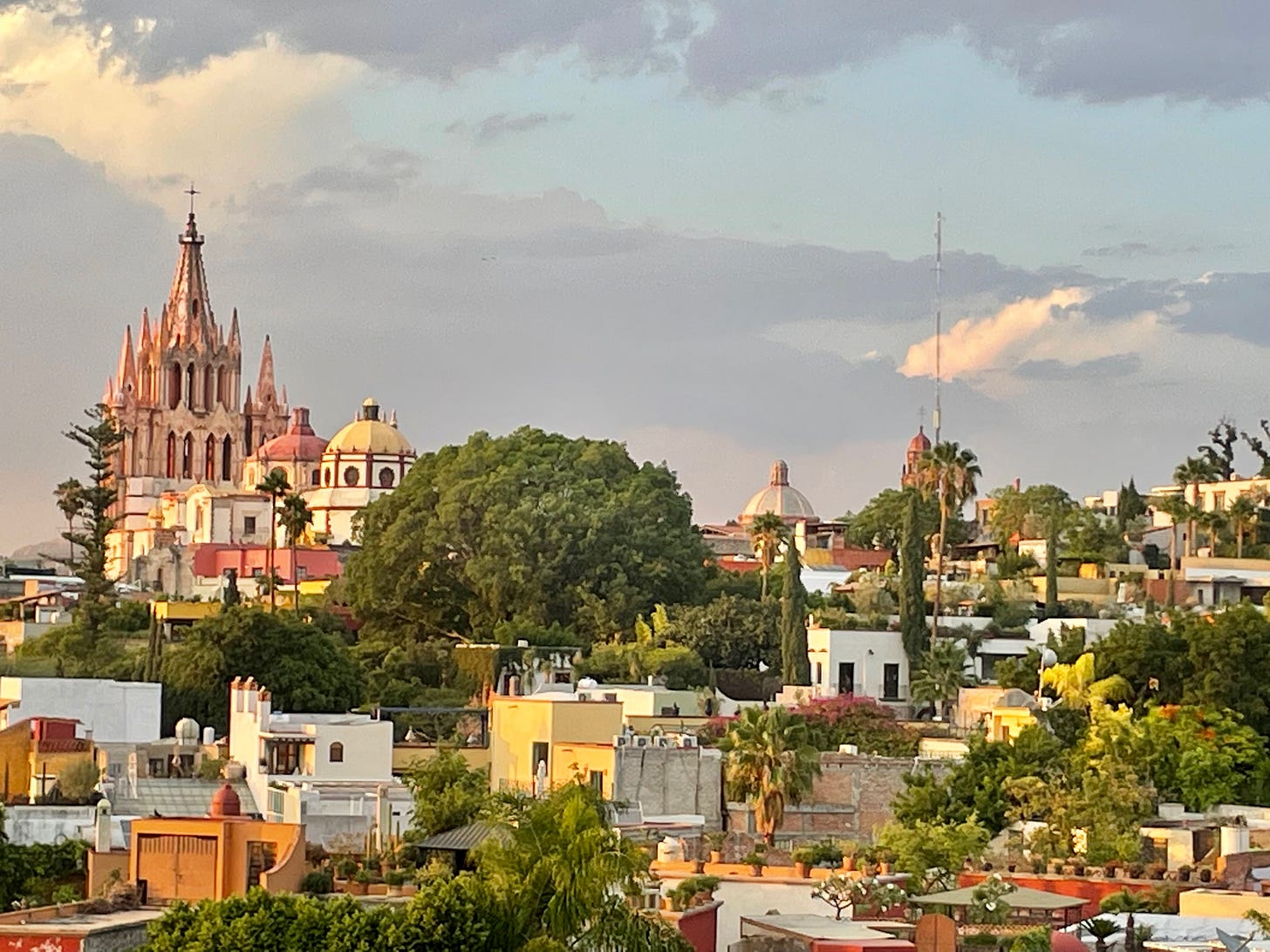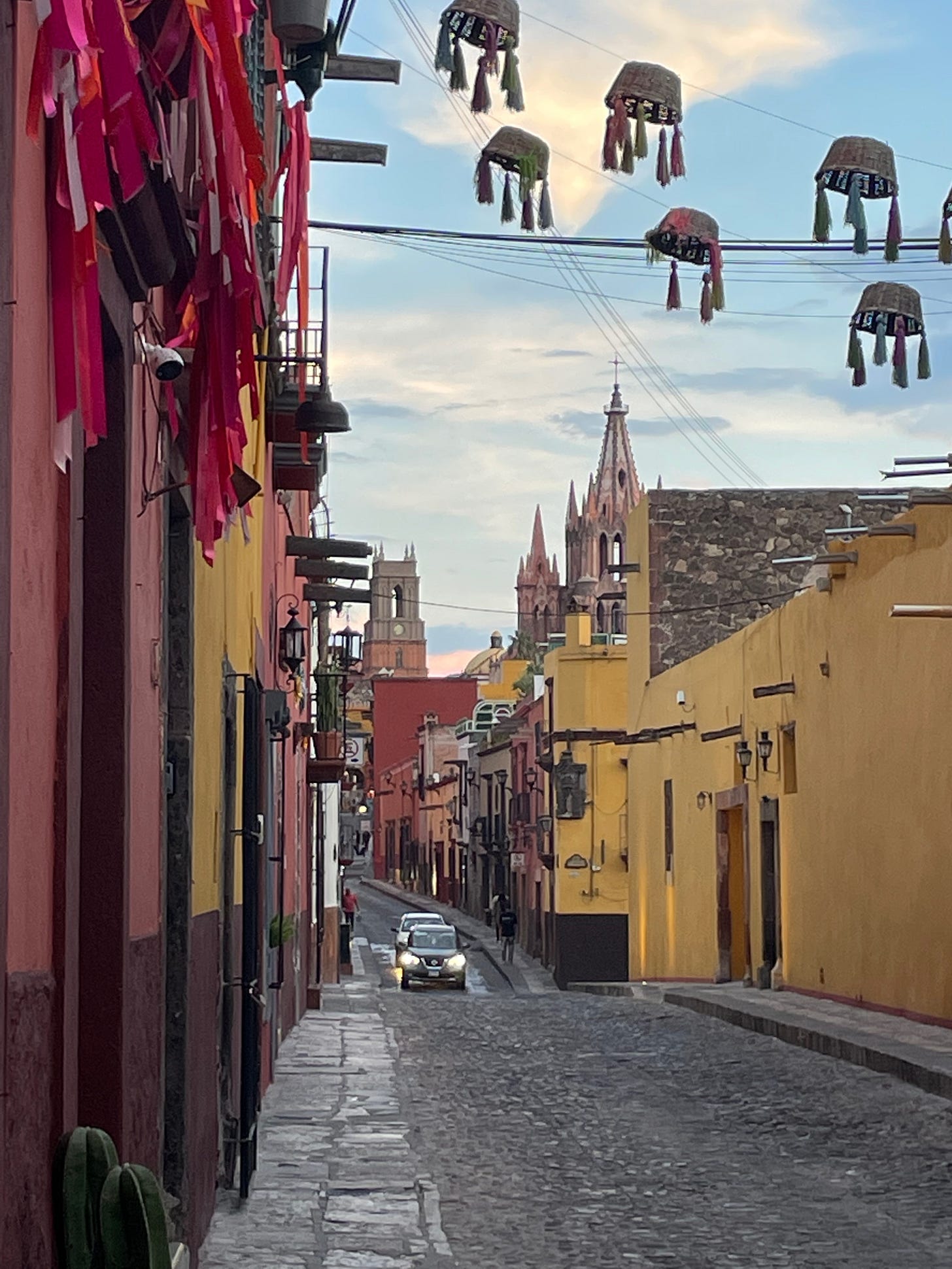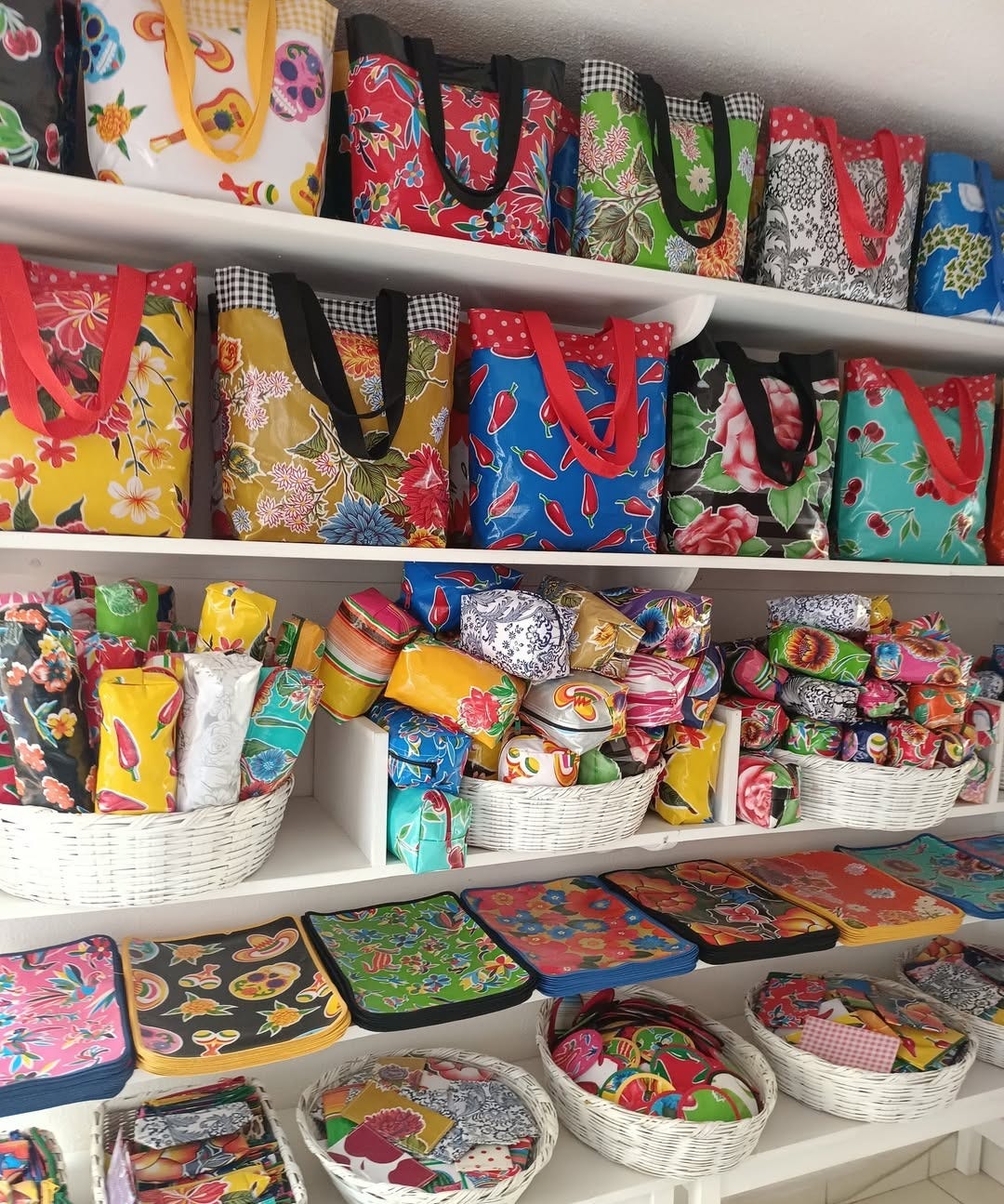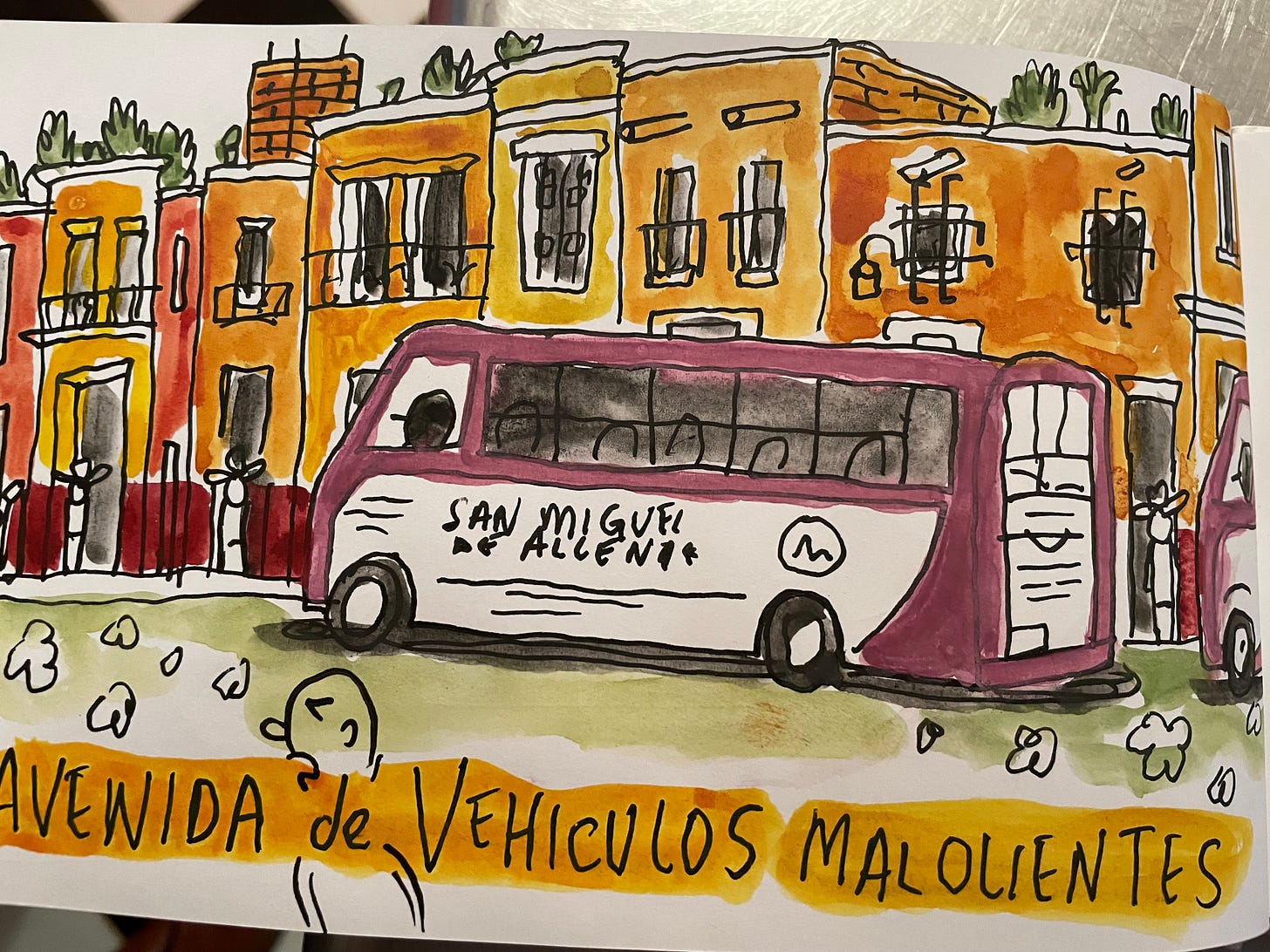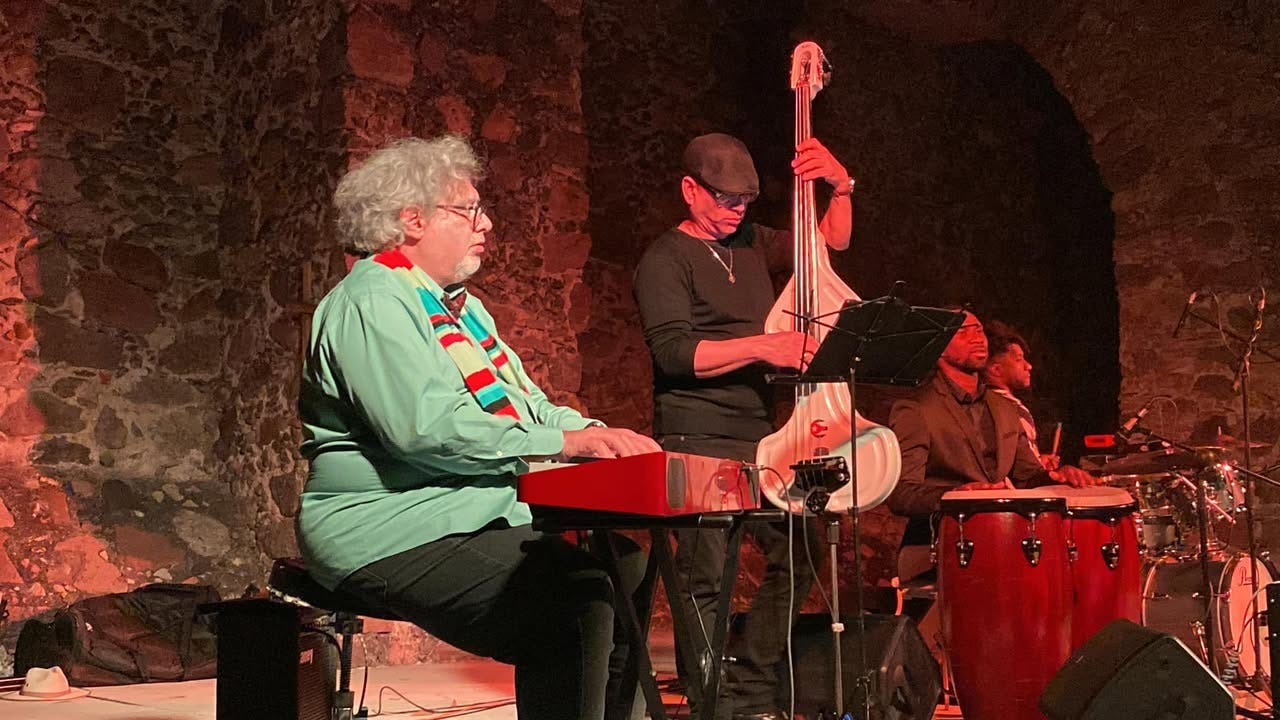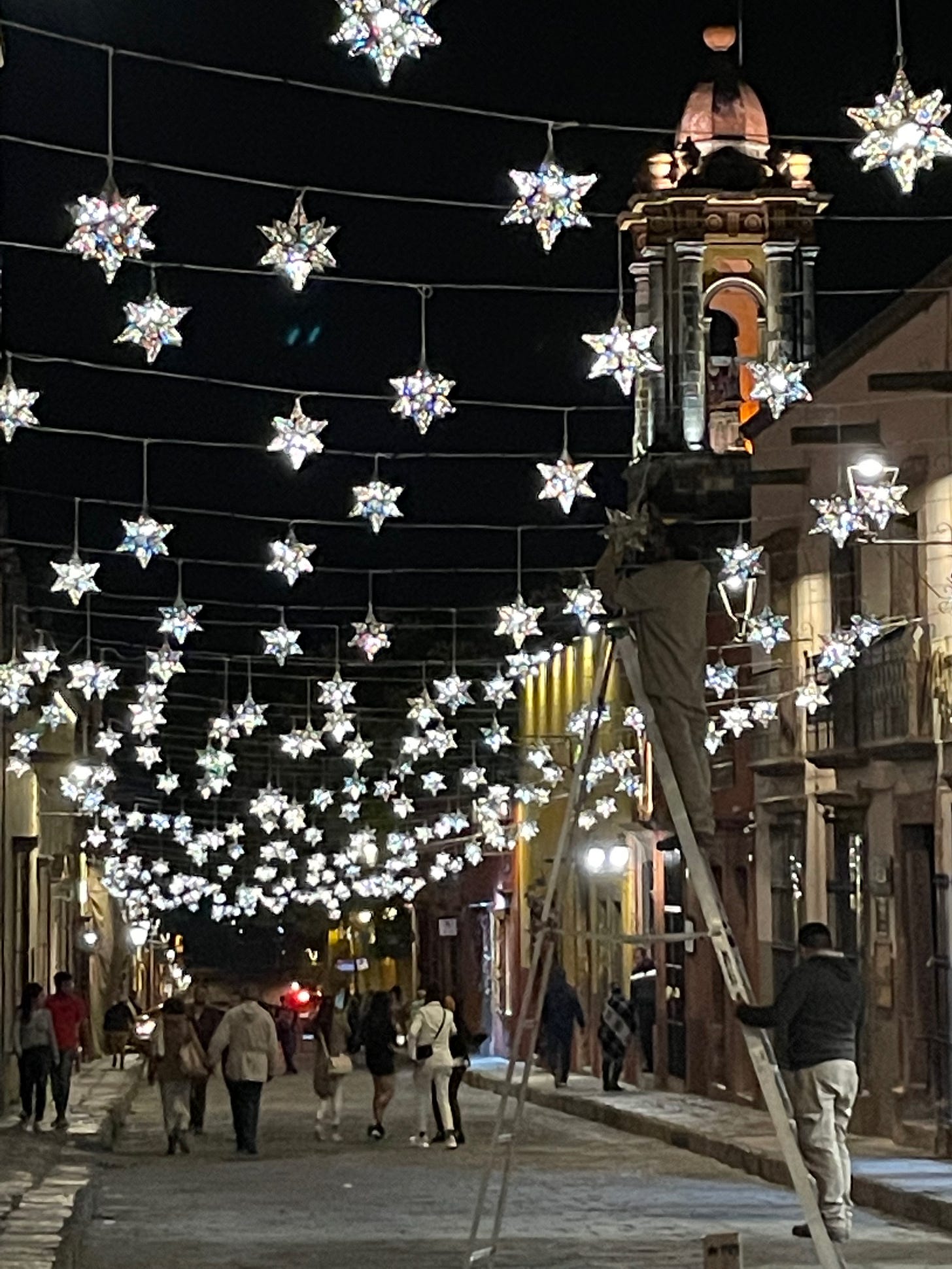Not just a pretty face
San Miguel de Allende, Mexico, for all its gringos and wealth, still retains its magic—if you're willing to slow down, learn some Spanish, and meet some Mexicans.
I have been living part-time in San Miguel de Allende, Mexico, for about 15 years. I first visited when my family lived here for a summer when I was ten years old, and I loved spongeing up a new language, wandering around the sunset-colored streets, browsing in the mercado, and taking art classes. At the time, there were few cars, and on Sundays, there was a procession around the jardin, where men strolled one way, hoping to catch a glimpse of one of the young women strolling in the opposite direction.
A view of the Parroquia in the center of San Miguel de Allende
As an adult, I was wary of returning, thinking that the pueblo had changed too much and would be overrun with gringos. Werner Herzog, in his jaw-dropping memoir Every Man for Himself and God Above All, described his time here:
I moved inland to San Miguel de Allende, a beautiful little colonial town now completely spoiled. Around the time I was there, the first wave of artists had begun to settle there, who over the decades were to draw vast numbers of confused and prosperous Americans after them, all wanting to get in touch with their creativity. I find it hard to set foot there now.
Indeed, his is still the hipster attitude about the town, and appropriate for someone who has made films, risking life and limb, about such topics as tribes in the Amazon who usually kill outsiders, grizzly bears, mad explorers, and daring volcanologists. Likewise, I never wanted to set foot in San Miguel de Allende again until 15 years ago, when a magazine paid my way to do a story about women who had reinvented themselves in the town—gringas selling real estate, decorating, or making jewelry. I ended up still enchanted with the place, and impulsively bought an 11 ½-foot-wide lot in the historic Centro, and, with the help of a talented young Mexican architect named Anja, built a little jewel box that has been a retreat for writing, reading, sitting in the sun, dancing, and, importantly, slowing down. Yes, there are a lot of gringos and wannabe artists here, but there’s a whole lot more.
I don’t think Werner Herzog ever went salsa dancing in San Miguel de Allende, for instance.
Recently the town has become wildly popular with wealthy Mexican tourists, couples looking for destination wedding venues, and Americans who are trying to flee the increasingly polarized and expensive US, and specifically another pinche Trump administration. A lot of Americans I know have asked for my advice about moving down here. Here it is: Learn Spanish. You’re going to Mexico.
I don’t say this flippantly, to sound like a language snob or congratulate myself for my fluency (though my friend Beatriz, who has patiently corrected my Spanish for years, recently told me I now speak well enough to be witty). I say it because it is the only way to become immersed in the culture, to communicate with the people who live here, to get out of a gringo burbuja and experience the things that, over the years, I have come to appreciate most. Mainly, that’s making friends with Mexicans and becoming a part of various Mexican communities.
Here are a few things I love about Mexico and this town, from spending my past few weeks here.
There are courtesies for passing on the narrow sidewalk and for cars letting each other go by, one by one.
Politeness
Mexicans always greet each other with pleasantries, even in emails. You can’t just write an email asking a question with no “Buenos dias,” or other greeting, with another line or two of cordiality. If you don’t do that, Mexicans are likely to respond with an exaggerated version of politeness, to remind you not to be so damn abrupt. You have to establish goodwill first, whether in stores or doing business. When you meet someone on the street, you can’t just wave and say you’re in a hurry. You take the time to acknowledge them and exchange a few words. If you’re with someone who runs across a friend you don’t know, they always introduce you, and you always shake their hand, or if they’re a good friend of a friend, kiss them on the cheek. There is never that awkward moment of someone not introducing you to a person they’re talking to while you’re standing there.
Likewise, when you take leave of someone, you say goodbye. There is no slipping out of a party, or just thanking the host. You have to take your leave of each person individually if it’s less than, say, a group of 15. This takes time, but everyone feels acknowledged and seen. When I go to a dance class, I greet and usually kiss everyone at the beginning and at the end of class. I love that, and the only other place that happens in my life is in my Cuban dance class in San Francisco, which is filled with Latinos.
People are polite on the street, too. There’s a hierarchy of how to pass on the narrow sidewalks: men get off for women, younger people get off for older people. It’s a little embarrassing for elderly men if you get off the sidewalk for them, so in that case, I pretend I have to cross the street so they don’t have to be the caballero and move for me. With traffic, there’s a strict rule of “uno por uno,” one by one, which people respect at intersections—with the exception of people from Mexico City. There’s very little road rage and people are patient on the narrow streets waiting behind someone who has to stop to get out of a car. This was even true when I was on a crowded bus and the driver stopped when a street vendor wanted to have him make some change for her—which given all the greetings, took a few minutes. Cars were piling up behind us, but everyone was perfectly fine with the driver giving a woman some change, even if it added a few minutes to their journey. No one is in a hurry here.
A feeling of enough
In the US it seems we are often scrambling for more—more stuff, more money. Our economy is built on making profits at any expense, and we casually dismiss inequities and even cruelties as “That’s just business” —an excuse that seems to trump (pun intended) everything.
Here, people are often satisfied with less. Yes, they want to make enough to be comfortable, but not necessarily rich, except for some upper-class Mexicans who have run the kind of kleptocracy that Trump aspires to. But for most people, there are other priorities—mainly family. Yesterday I ran into Mario, who runs a little store on my block that sells oilcloth bags and accessories. I’ve known Mario since I moved here, back when we had a misunderstanding based on my then sketchy Spanish. He’d asked me out a few times, and I’d laughed him off, until once I thought maybe he might make a good dance partner. “Okay,” I said. “Tengo que aprender salsa.” I need to learn salsa.
Mario has no desire to publicize his oilcloth store on Calle Loreto: “I have enough.”
He lit up and said he’d come over to my house with tomatoes, onions, and peppers to show me how. I meant bailar salsa, and he doesn’t dance. Since then, we’ve shared a little joke. How’s your salsa coming? It’s spicy.
Yesterday, I told him I’d seen a posting on Facebook mentioning his store, asking about the name since they couldn’t find the website to buy more. Mario shrugged and said he had no interest in social media, it’s just the oilcloth store, and he’s been in business for 25 years and plenty of people manage to wander by and find it without a sign.
Maybe call it Mario’s? I suggested. In my head, I was going into American marketing mode. He could post it on San Miguel de Allende Facebook pages! Create a logo! Do Insta posts with people carrying his bags around town! Get business cards! Sell online! Make more money! He shook his head.
“You don’t need more customers?” I asked.
“I own the house, I sell plenty. Why would I want more?” he asked. He’d have to spend less time with his family and friends to do all that.
Why indeed.
Going all out
Mexicans in this town love parades, celebrations, fireworks, and over-the-top decorations. It seems like nearly every night there are fireworks (as I write this, I’m sleepy from having woken by the bursts at 4 a.m.) and every weekend there’s some kind of parade. Last weekend, there was the bus parade. All the town’s buses were cruising down the street, honking their horns and playing their noisemakers, their buses festooned with balloons, Christmas wreaths, neon lights, anything colorful (individual buses are almost always decorated on regular days, too, with the Virgin of Guadalupe, stuffed animals, dice, colorful paint, plastic flowers). The children of the drivers were leaning out the windows and door, waving. People stopped, watched, and clapped.
From a gringo perspective, a bus parade seems like an awful idea. It tied up traffic. It was terribly noisy. It was a waste of fossil fuels and fouled the air of an already pretty polluted town. But it was also fun to see townspeople, drivers and people on the street alike, take pride in their public transportation, cheering it on.
My cartoonist friend Lloyd Dangle drew this San Miguel de Allende bus
During the Christmas season, everyone decorates. The town is lit up with stars and icicle lights, every store has poinsettias (nochebuenas) outside, and entrances are festooned with colorful ribbons and lights. The parties, beginning around the 20th, are nonstop—families host posadas, opening their houses to neighbors who reciprocate on another night. My dance class has a posada. My block has several posadas. Everyone has a posada, with tamales and punch.
All of this decoration and partying can seem gaudy and the partying excessive. But it’s like there’s too much joy and color to contain.
The famous pink Parroquia in the center of town is an iconic example of the town’s over-the-top decor. The church, originally built in the 16th century, was remodeled in 1880 based on a postcard of a cathedral in Paris. But rather than use a sober grey, they made it bright pink.
Dance
I have been dancing since I came to town, taking classes at the local community center, and going out to clubs. Here, one can go salsa dancing almost every night at a place within walking distance, often with a live band or killer DJ. I take private lessons with a Cuban maestro for about $25. I have come to know a lot of people in the dance community, making the rounds with kisses when I arrive at a venue with a couple of my dance amigas.
Last night, at a winery outside of town, there was a socialito with a band. It was like a dream: one after another excellent dancer asked to spin me around the floor. The atmosphere was muy buena onda, very friendly, with no one sitting and stewing about having no partners. It helped that there were taxi dancers, men who get communal tips to dance with the over-abundance of women (a practice, to be fair, that I started two years ago with a Cuban dance festival I organized).
Dancing at El Pavo Real outside San Miguel de Allende. Maestro Everardo Zapata, seated on the right, has created taxi dances and salsa rueda classes so even in a town with too many followers, no one sits out.
There’s a big difference between dancing here and in the States. There’s more of a sense of dancing for the sake of dancing, and an appreciation of people who dance well, regardless of their age. Whereas in San Francisco clubs, I can just sit there without anyone asking me to dance until I corral someone from my dance class to spin me around—it’s more of a potential hookup scene, and I’m too old for that—in San Miguel de Allende, I dance one song after another. I feel like a part of a friendly community, and regardless of my age or theirs, people dance with me because after all these years, they know I’m fun to dance with.
Art
It is true that this is an artistic community; gringos first started coming down here when it was possible to attend the pueblo’s two art schools on the GI bill and live like kings. Hippies followed in the 60s, and artist galleries, workshops, and classes metastasized. There’s a lot of pretty amateur stuff, but there are also plenty of excellent artists—in my experience, especially photographers.
La Fabrica Aurora is an old textile factory that has been converted into art and design galleries. The quality of the art is highly variable, but among the galleries, Rene Torres’ Torrente Galeria, which often features the best local and Mexican photographers, stands out.
Just the other day I visited the studio of Daniela Edburg, whose work has been exhibited in several museums, where she showed two Mexican friends and me the brains she’d been knitting, the volcanoes she was constructing from felt, and photos that look like Dutch masters with sly differences. A feminist artist, she first came onto my radar when I saw her Drop Dead Gorgeous series, with constructed photos of women who died by means of tools that oppress women and their bodies. I bought “Death by Artificial Sweetener” several years ago, and just added “Death by SlimFast” to my collection—appropriate for someone who has written extensively about the diet industry and how fucked up our culture is about women’s bodies. Daniela also does still life photos with unexpected elements; still lives were the only paintings women were once allowed to paint, because they were domestic and not big important religious pieces; Daniela adds knit objects (another female art) with winking references, like a salad dressing bottle that’s really a Molotov cocktail.
I’m a fan of her and other local photographers who experiment with techniques and themes, many on display at Torrente Galeria in the Fabrica Aurora. There are also plenty of good painters in town, along with the ones who rent studios and buy canvases to fling paint around to find themselves and their creativity—and good for them, too (just don’t ask me to hang any on my walls).
Then there are the artisans, though fewer every year as the mercado becomes more infested with Chinese-made tchotchkes. But many still remain – weavers, jewelry-makers, potters. Some Mexican artists are incorporating old techniques with new; my favorites are from a young Huichol couple who sell jewelry on my street, and a friend who combines old Mexican textiles with her own weaving to create one-of-a-kind shawls and huipiles. As you walk the streets of San Miguel de Allende, art is everywhere.
Music
The number of excellent musicians in town is practically embarrassing. I am a particular fan of Cubans who’ve moved here. You can go to a little club with an outdoor courtyard, Paprika, and listen to world-class Cuban music for the price of a couple of margaritas. I am such a fan of the Cuban pianist Gabriel Hernandez, who has toured with the Buena Vista Social Club and has played with a lot of greats, that he must think I’m a stalker. He recently was gravely ill and the community came together to help fund his recovery, and he is back at the keys with nearly the same proficiency.
Cuban musicians including pianist Gabriel Hernandez made the San Miguel de Allende music scene vibrant.
There’s another Cuban singer with an incredible voice, Magda Macie, and a wildly talented percussionist, Victor Monterrubio, who play at a small and charming Cafe Rama on Tuesdays, with a Cuban dance teacher, Patricia Bellati, who gets everyone moving, including the table of 70-year-old gringas who initially sat like stones. Meantime, on Wednesdays, a salsa duo plays at a terrace restaurant, where everyone dances
Patricia Bellati gets everyone dancing at Cafe Rama.
And that’s just the Cuban and salsa music. The town invites big names to play in the central jardin during the yearly jazz fest, including Herbie Hancock and the Gypsy Kings—for everyone, for free.
Felices fiestas! Putting up the Christmas lights.
There’s a lot to complain about with San Miguel de Allende. The prices are very high compared to other towns—it’s like the Aspen of Mexico. The traffic can be terrible (one reason I like living in the Centro is that I can walk almost everywhere). There are indeed a lot of gringos, many of whom can barely say “buenos dias,” or don’t feel that they should bother. But it’s a sizable town, and only 13% are foreigners, and if you take the time and slow down and learn some Spanish you can immerse yourself here in some warm and wonderful communities.



